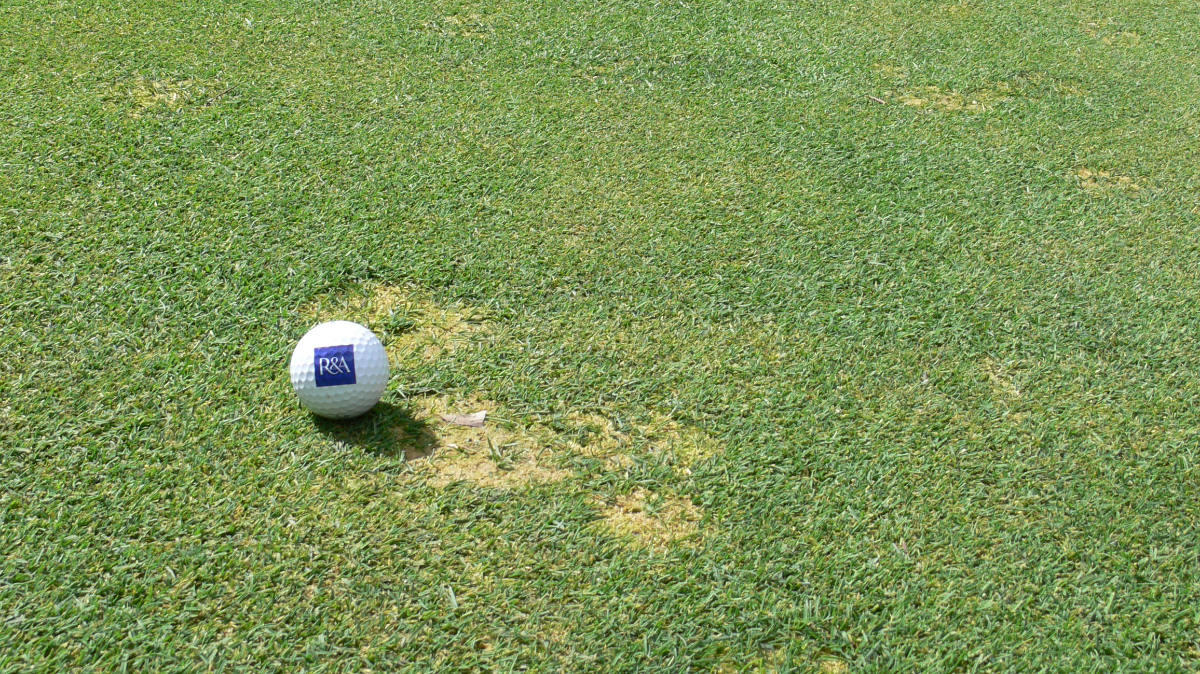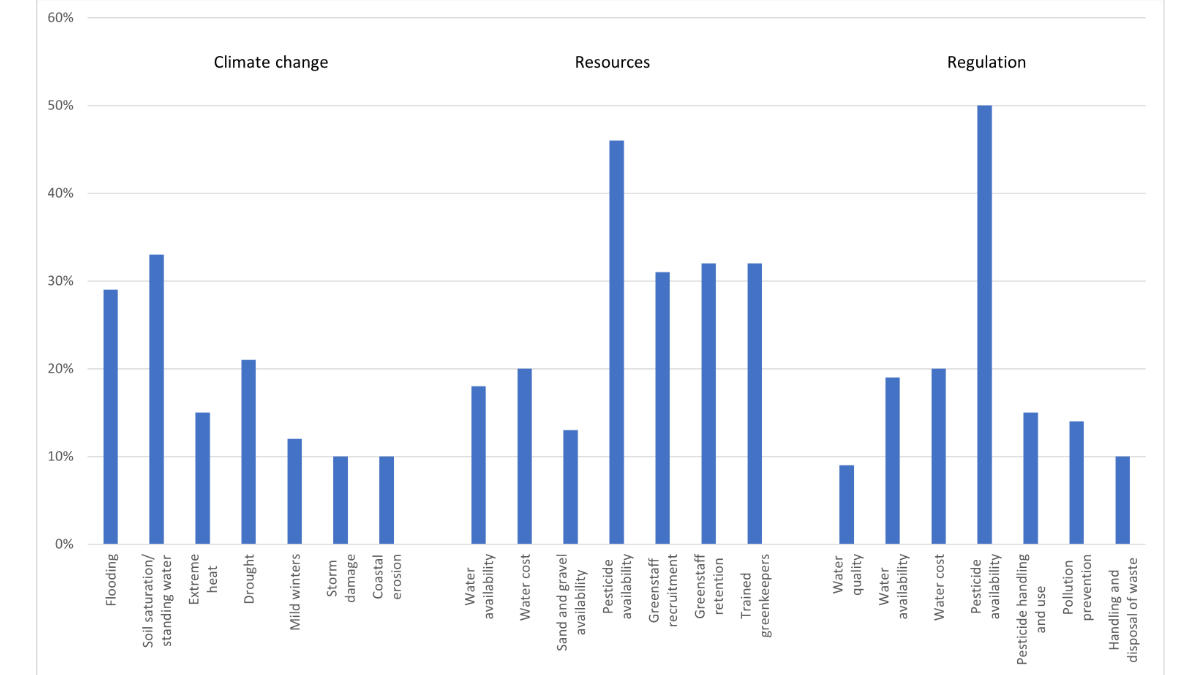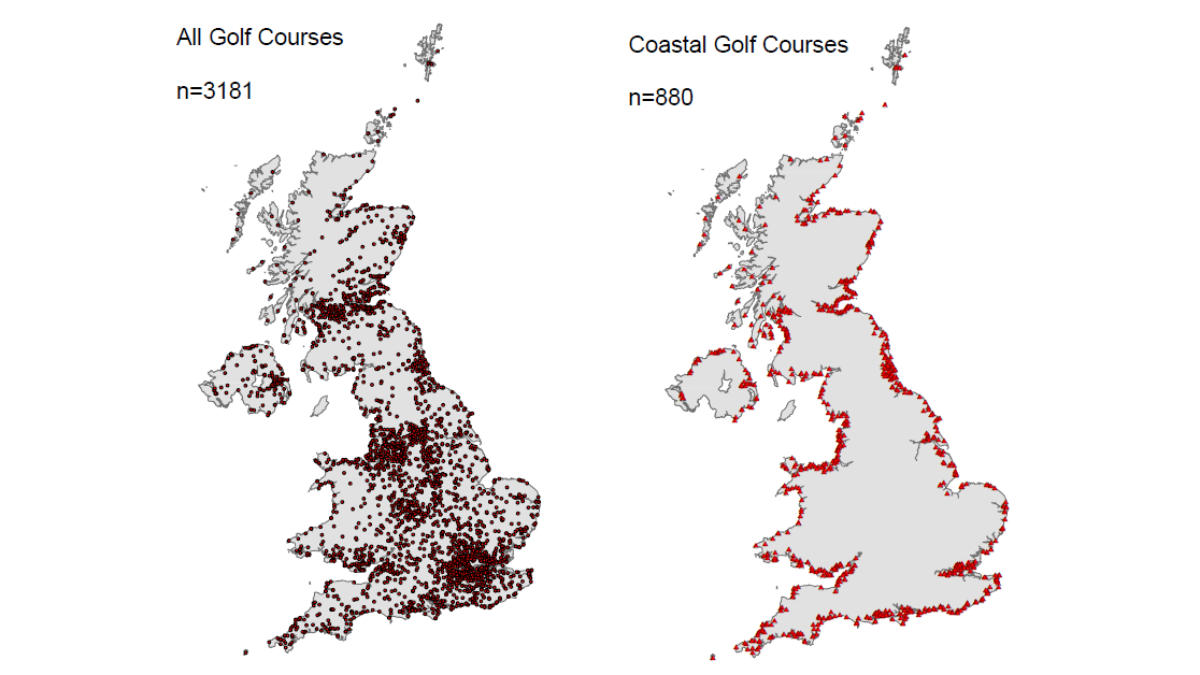- Homepage
- News and Features
- The R&A has provided an update on its Golf Course 2030 initiative
The R&A has provided an update on its Golf Course 2030 initiative

Golf Course 2030 (GC2030) was established by The R&A in 2018 to mitigate the impact of climate change, resource constraints and regulation on golf course condition and playability.
This will be achieved through a programme of research, education and communications. The research programme has been, in part, informed by the results from a questionnaire survey commissioned by The R&A and undertaken by Sports Marketing Surveys Inc.
The survey asked course managers, club managers and PGA professionals their views and experiences of climate change, resource constraints and regulation in relation to the golf course. Three articles have now appeared in ‘Greenkeeper International’ this year, covering the survey responses to each of these challenges, as shown in Figure 1.
The final GC2030 article this year will consider how the research programme reflects the views expressed in the survey and how it contributes towards addressing some of the most serious issues affecting the sport.
Major concerns for the condition of our golf courses

The single most important issue for course managers identified by the SMS survey is the availability of pesticides. The prospect of us seeing more disease scars, insect and worm damage as a consequence of the limited availability of chemicals and weather patterns conducive to such activity is a most worrying one, with its potential to severely impact the playability of our golf courses. Comments from course managers in the survey clearly reflected concerns that a lack of pesticides will be detrimental to the appearance of the course, resulting in unhappy golfers and criticism of turf professionals.
Two of the 14 Golf Course 2030 projects underway address this issue directly:
- Integrated management of diseases and insect pests on European golf courses. Managed by the Scandinavian Turfgrass and Environment Research Foundation (STERF), this project is investigating sustainable options to the use of pesticides. The focus will be on microdochium patch, dollar spot, chafer grubs and leatherjackets.
- Integrated turf management for golf greens, managed by STRI Group. This will see the production of a ‘best management’ handbook for parkland golf courses, which will promote positive action to address the challenges posed by climate change, resource constraints and regulation.
There are other GC2030 projects which may not be obviously related to the issue of pesticide availability, but that do cover important elements of the challenge. These are:
- Quality standards for the condition and playability of the golf course. Any club wishing to set objectives for what they want from their golf course will have to take the prevailing disease, pest and weed management situation into account. It is difficult to set any kind of standards, never mind high ones, if there is limited understanding of the potential barriers to achieving them.
- The decision-making process for grass selection, managed by STRI. Some grasses are less prone to disease damage than others. Grass breeding is, therefore, an important part of the battle against pests and diseases. Having this as part of the decision-making process as to which grasses you favour on the golf course could be critical in allaying the fears of turf professionals that they will be blamed for any deterioration in course condition.
- Adapting to new technologies (as sustainable options for disease, pest and weed management become the norm), adopting best practice and understanding the level of challenge posed by climate change, resource constraints and regulation may well require a fresh look at the content of the education currently provided to our greenkeeping workforce. The GC2030 project ‘Education for the greenkeeping workforce’, managed by SRUC, will address this.
Flooding and drought (and associated water availability) were also issues that course managers felt were a threat to golf course condition and playability. Survey responses showed that these consequences of extreme weather are experienced widely and that golf facilities are, generally, not well placed to address them. There was a regional trend to this view for drought, with those in the southeast of England expressing the highest level of concern. While the grass selection project already mentioned will include drought tolerance as one of the things to consider when choosing grass species, there is one major GC2030 project that is looking at water management in terms of dealing with too much (flooding) and coping with too little (drought).
STRI will be responsible for delivering the project ‘Water management on Golf Course 2030: how will it affect the golf industry and what can be done to prepare golf for future climates’. This project will review the impact of climate change on water supply, usage and drainage for golf courses. In reviewing current water management practices and considering emerging technologies, the outcomes from the project should provide course managers with the ability to develop plans to cope with these issues on their golf course. These plans may incur higher costs for implementation but failure to effectively address these challenges with sustainable solutions may come at an even more substantial cost.
There are two issues covered by GC2030 projects that received less than 15% response in regard to the level of concern of course managers: coastal management and aggregates (sand and gravel) availability. With such a low level of concern, why invest in research on these topics?

While coastal management may not be a concern to those managing our inland golf courses, the SMS survey showed that it is a real concern to 59% of those respondents managing our coastal, links and clifftop courses. The coastal management projects are:
- A survey of coastal courses to identify current levels of coastal management understanding and engagement across courses likely to be impacted by coastal change. The outcomes of the survey will inform other projects.
- Coastal Management Study, which will produce a trialled template plus user guidance for a Coastal Golf Course Management Plan, structured to enable effective interaction with Shoreline Management Plans and similar broader coastal management processes.
- Coastal Management Innovations, which will enable the golfing community to apply innovative coastal management approaches and consider ecosystem benefits in their management decisions, to secure a sustainable long-term future.
- A demonstration project for an innovative system of erosion mitigation of coastline at risk, providing proof of concept as a practicable and sustainable technique for mitigation of soft coastline erosion at acceptable cost and environmental impact.
- A blue carbon audit to assess how these resources can provide effective opportunities for golf courses in relation to climate and coastal change mitigation and adaptation.
The apparent lack of concern over the availability of aggregates probably reflects the fact that any shortage will not be seen in the near future. However, some supplies will run out in 30 years or so and part of the purpose of GC2030, and the responsibility of those deciding on priorities for research, is to consider not just the immediate but also the medium and long-term challenges. The GC2030 project related to the availability of sand and gravel will:
- Review the requirements of golf courses for aggregates and the specifications of materials for use on golf courses.
- Engage with the aggregates supply trade to assess what materials are available and the longevity of their supply.
- Investigate alternative products and solutions for dealing with aggregate supply shortages.
- Investigate the impacts and opportunities of using sub-optimal or alternative materials.
Is Golf Course 2030 addressing the concerns of course managers?
The issues course managers expressed most concern over in the SMS survey are the subject of GC2030 projects. The outcomes of the research will help us drill down to better understand the challenges and to determine what additional work needs to be done to support course managers. There are projects which did not score highly in the survey, such as aggregates, which possibly reflects an understandable here and now attitude to the challenges the greenkeeping profession is battling against, rather than looking at what will be facing us in the future.
At the end of the day, GC2030 will be judged on how valuable it is as a source of awareness raising, information from research and education and if these key aspects of the initiative can be applied to help increase the resilience of our greenkeeping professionals and our golf courses.
Author

